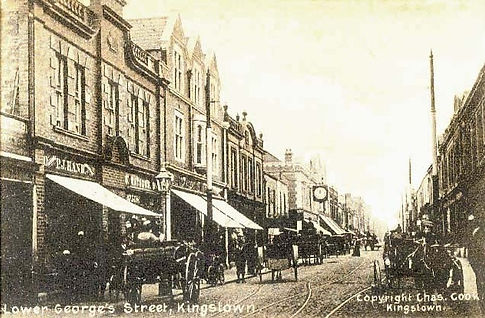Kingstown (Dún Laoghaire) and Monkstown
Links
Dublin city heritage database - A useful starting point to see where you can find records - compiled by the Dublin City Libraries
Irish Genealogy - This site is still growing but has a large number of parish records. I have found a few records here and hope to find more in time. There are also links to other sources.
Maritime Art and Dún Laoghaire - from the National Maritime Museum of Ireland's website comes this talk by Cormac F. Lowth. A very specific topic but interesting and sheds light on the maritime history of the town.
Desmond McCarthy, Artist - this Irish artist seems to be a local - he has lots of beautiful paintings and drawings of Dun Laoghaire on his website.
Dún Laoghaire harbour- historical information about the harbour.
Dún Laoghaire Borough Local History Society - not so much information but a useful contact for finding out more about the town.
Historical picture archive - historical pictures to buy


In the period that the Nasons listed at left, lived here, the town was known as Kingstown - from 1821-1920 in fact, but since then it has reverted to its original Irish name of Dún Laoghaire - no doubt to celebrate Irish independence. It has also been known as Dunleary which is an anglicised version of the Irish pronunciation of the name. The name means the fort of Laoghaire, who was a fifth century high king of Ireland who used it as a base from which to raid the British mainland.
Dún Laoghare is located some 12km south of Dublin central on the coast, and as such is a popular seaside destination. The harbour is no longer a major port but is very popular for recreational water sports.
Prior to the nineteenth century Dún Laoghaire was a very small settlement and fishing village, but a major shipping disaster in 1807 prompted the then government to look to constructing a safe harbour for Dublin. The construction - shown clearly in the aerial photograph below consists of two piers, enclosing a proposed deep harbour. However, the entrance is so wide that it enables silt to enter and make it unsuitable for really large ships. King George IV visited the new port and the town was renamed Kingstown in his honour. A raliway to Dublin, (the first suburban railway in the world) was built and it became a desirable Dublin suburb, which it still is today. And, of course the town grew - the main street also named after King George - George Street.
It seems to have a thriving artistic community.







The tower portrayed at the beginning of James Joyce's Ulysses was one of the original Martello towers built to protect the new port. It is now a James Joyce museum and is portrayed in the painting on the left.
Other landmarks are the ornamental fountain near the harbour and the large park constructed in the centre of town. There are many large and gracious houses in the town because, then, as now, it is a very pleasant place to live and still be close to Dublin. Our Nason ancestors lived in some of these.

Monkstown
I have included Monkstown because it is here that Sarah Frances Bateman and John William Washington were married.
Unlike Dún Laoghaire, Monkstown has a castle, that dates back to the eleventh and twelfth centuries. Until around 1800 there was little in Monkstown other than the castle and other grand mansions scattered around the countryside. With the development of the port of Dùn Laoghaire, Monkstown was also drawn into the development but not on such a large scale. Many of the large mansions remain.




More links
The James Joyce Tower and Museum - Housed in the tower that begins Ulysses is a James Joyce museum with memorabilia, etc.
The History of the County of Dublin - a Google book by John D'Alton, dated 1838.
Dún Laoghaire Walking Trails - if you are lucky enough to go there here are a few trails to take you around the place.
History of Monkstown Parish - I think this page is produced by Monkstown church but it includes a much more general and interesting history than that.